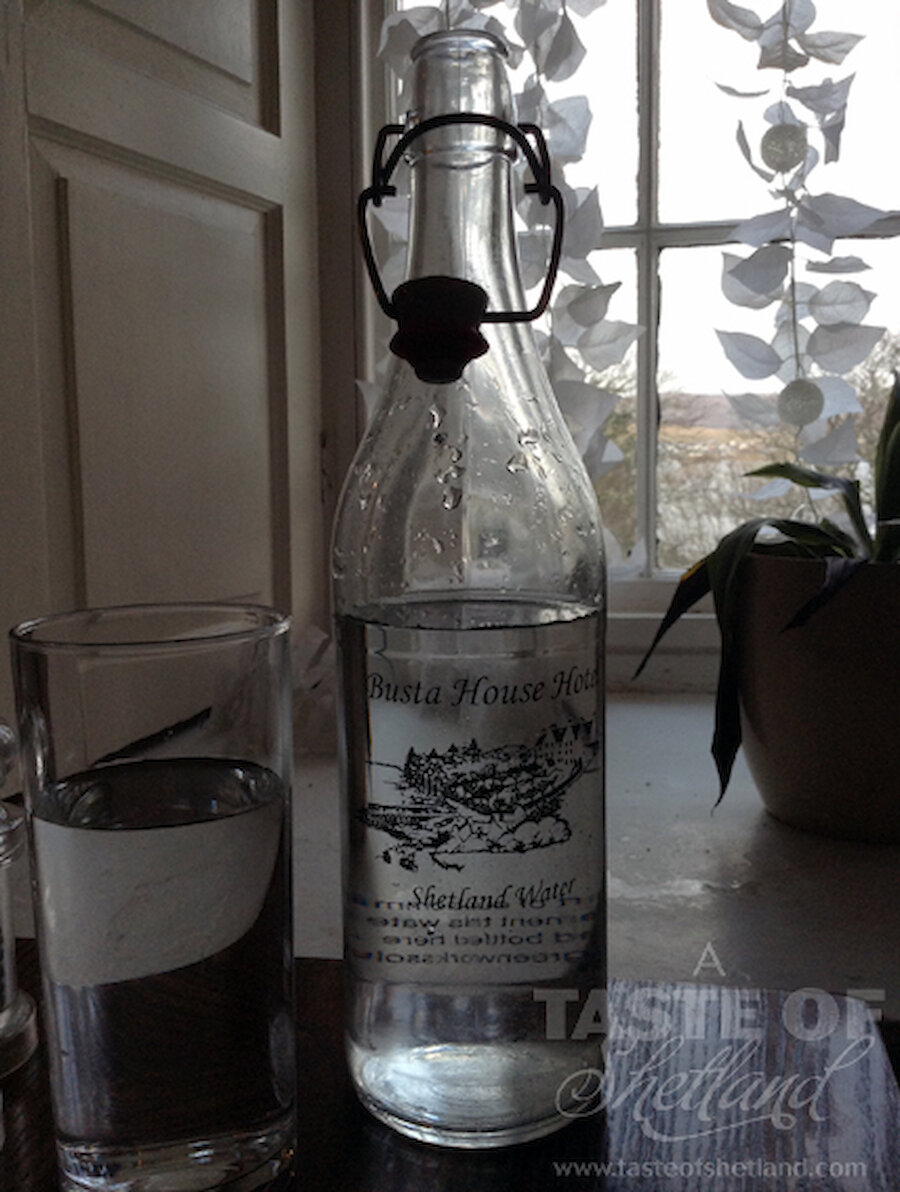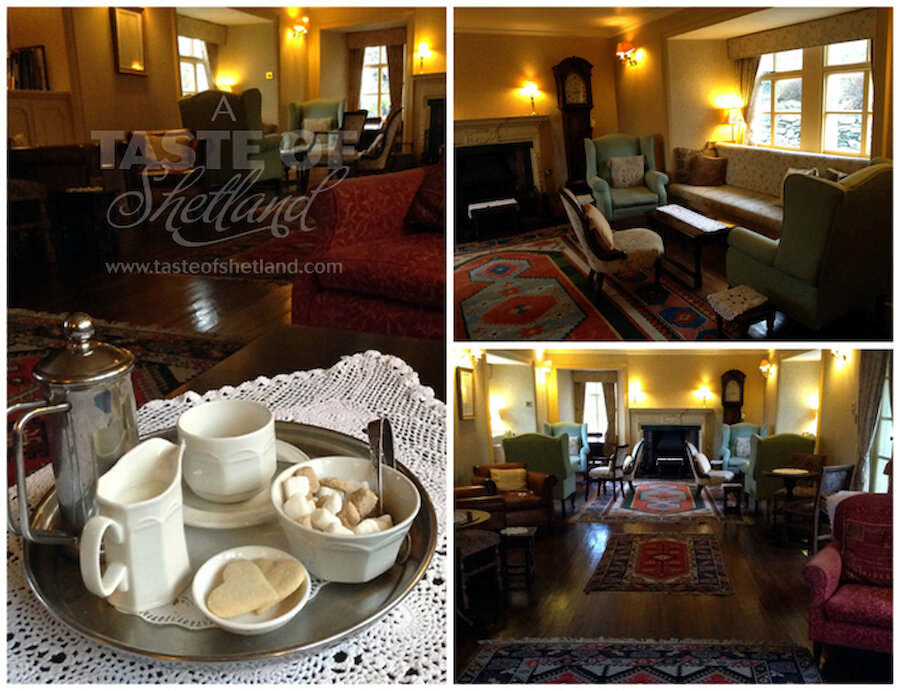There has been a copy of The Story of Busta House by local writer Marsali Taylor sitting on my bookshelf, untouched, ever since a kindly neighbour gifted me a copy shortly after its publication in December 2012. I've been meaning to read it but never found the time, until recently.
The Busta House Hotel is situated in central Shetland on the quiet shores of Busta Voe, near Brae, and I've had the pleasure of visiting this venue numerous times over the years. I've experienced their popular 'Afternoon Tea' with friends in the beautifully decorated Long Room and mouthwatering meals with family and friends in the cosy bar area. Once, several years ago, my husband and I sat silent, wide-eyed and enchanted as we listened to the talented lyric soprano Oksana Mavrodii (accompanied by classical pianist Anna Mavromatidi) perform in the Long Room (an occasional Shetland Arts venue), before retiring to our room for an overnight stay.
I knew, back then, that the building was very old and there was a story surrounding the place, but I had no idea what the story was. Prior to our overnight stay we'd been jokingly warned to watch out for the ghost of a woman but that was all I knew (and we never saw any sign of a ghost!).
I'm always on the look-out for inspiration for Taste of Shetland posts and so I took Marsali's book off the shelf and read it, captivated, in one sitting. The story is one of family, love, jealousy and distrust, tragedy, an illegitimate child, heirs, mystery, intrigue, bankruptcy and ruin. It has all the elements of a good drama novel or film! I confess to have become somewhat teary-eyed at reading a journal entry where a father's children one by one are struck down with smallpox, with devastating consequences.
Marsali's book says that the first record of Busta House (or 'Bjarstadt', Bjorn's place) is in a deed from 1488. The original house dates from 1588 making it the oldest continuously inhabited house in Shetland. Since then there have been some additions and refurbishments, but the building maintains a graceful ancient air. It is currently owned by Joe and Veronica Rocks who run it as a hotel, bar and restaurant.
I telephoned Busta House and explained that I wanted to write A Taste of Shetland post on their establishment (and I was really keen to visit the place with my newly educated eyes!). They ever so kindly invited me up for Sunday lunch and a chat.
Lunch was served in the bar area, a small, character-filled room built in 1720 with a heavy beamed low ceiling and white washed walls. The room is illuminated with electric lanterns and decorated with brass jugs hanging from the ceiling and sketches of fishing boats. There's even an old sword hanging on the wall by the entrance to the restaurant area (I meant to ask the story behind that sword! I must remember to ask the next time I visit).
I was delighted to see a wide variety of local Shetland produce on the menu, from fresh organic Shetland salmon, plaice, mackerel and haddock in Unst ale batter, to Shetland hill lamb, oatcakes and freshly made bannocks. As part of their commitment to the environment Busta House filter, chill and bottle their own water in the most gorgeous old-fashioned stoppered bottles.
I was impressed that each table had its own sea salt and peppercorn mills so you could grind your own seasoning. There's nothing worse than sitting down to a nice meal only to find stale pre-ground black pepper shakers. It is this attention to detail which helps elevate a meal from good to excellent, I believe, but I'm a big fan of freshly ground black pepper!
I'm fond of black pepper so much it was the Shetland smoked peppered mackerel fillets I chose for lunch. This was served with whisky butter, a lovely fresh, crisp salad, coleslaw, Shetland oatcakes and a freshly baked Shetland bannock on the side. The locally sourced fish was flaky, moist and bursting with flavour. I thoroughly enjoyed every delicious morsel while I admired my surroundings. It's not every day I eat lunch in 18th century surroundings!
Afterwards coffee and biscuits were served in the Long Room while I enjoyed an informal chat with the hotel managers Grant O'Neil and Joel D'Eathe. The Long Room is the oldest area of the house and it is furnished in a very romantic antique style with comfortable couches and chairs, fireplaces at either end and several bookshelves and coffee tables . The walls are adorned with original paintings of the key characters in The Story of Busta. It is an ideal setting for a post-meal coffee or for an afternoon gathering with friends. It is also frequently used as wedding venue.
Following coffee I was treated to a tour of the premises where, in one of the 22 individually decorated bedrooms, two signatures from people in The Story of Busta House are hand written on the stone wall! They are covered in glass for preservation, but the names are clearly visible, written in beautiful 1700's style.
I highly recommend you read up on the history of Busta House before visiting, as it really does change your outlook of the place when you are there. It did for me, at least. One of the descendants of Busta, Frances Scott, wrote another account: The True Romance of Busta, first published in 1934 which is available at Busta House itself. I'm thoroughly enjoying her read just now.
To tempt you to read it, I'd like to share a paragraph I enjoyed from the Authors Preface:
Nearly everybody, who is anybody, knows now where Shetland is; although, not so long ago (Shetland being "out of the map,") a great deal of ignorance, on this subject, prevailed, even among comparatively educated people. They know now that the Shetland Islands do not lie close to their sister group of the Orkneys; but are separated from them by a day's journey wild waste of stormy waters, with no intervening land, except the little Fair Isle (which cannot be approached by the steamer). The voyage is a hefty one, although (we understand) real sea-lovers love it; but the majority of land-loving mortals find it a bit of a penance. But once achieved, its pains are, for the time, forgotten, in the pleasure, variety and comparative peace of the new surroundings; it's pleasant, plausible inhabitants, and quiet, tranquil life. It speaks a great deal for the charm of the islands, than in spite of the rigours of the journey, people, having once visited them, often apparently cannot resist repeating the experiment, but return again and again to the scene of their enchantment.
*Lunch was provided by Busta House.





